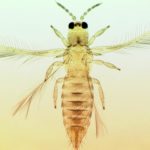
For the last 10 years, the IR-4 Ornamental Horticulture Workshop has ranked developing efficacy data on new products to manage thrips as a High Priority Project. Thrips remain an important threat for several reasons: 1) the damage thrips cause to ornamental horticulture plants, decreasing the value of the infested crops; 2) the tospoviruses (tomato spotted wilt, impatiens necrotic ringspot) they can vector; 3) the newly arrived invasive species which impact at least 250 different ornamental horticulture species; and 4) growers lack the ability to rotate among 3 to 4 different modes of actions to effectively manage resistance development in the thrips populations they must control to maintain economic viability. From 2005 through 2017, 81 products representing 53 different active ingredients were tested for thrips management. These products represented both biological and chemical tools. Some products were already registered but more data were needed particularly with the newly invasive thrips species or they were considered standards to measure the level of efficacy achieved with other materials. Other products were in development but have not yet been registered with the EPA. The five thrips species tested in the IR-4 program were Chilli Thrips (Scirtothrips dorsalis), Gladiolus Thrips (Thrips simplex), Privet Thrips (Dendothrips ornatus), Weeping Fig Thrips (Gynaikothrips uzeli), and Western Flower Thrips (Frankliniella occidentalis).


